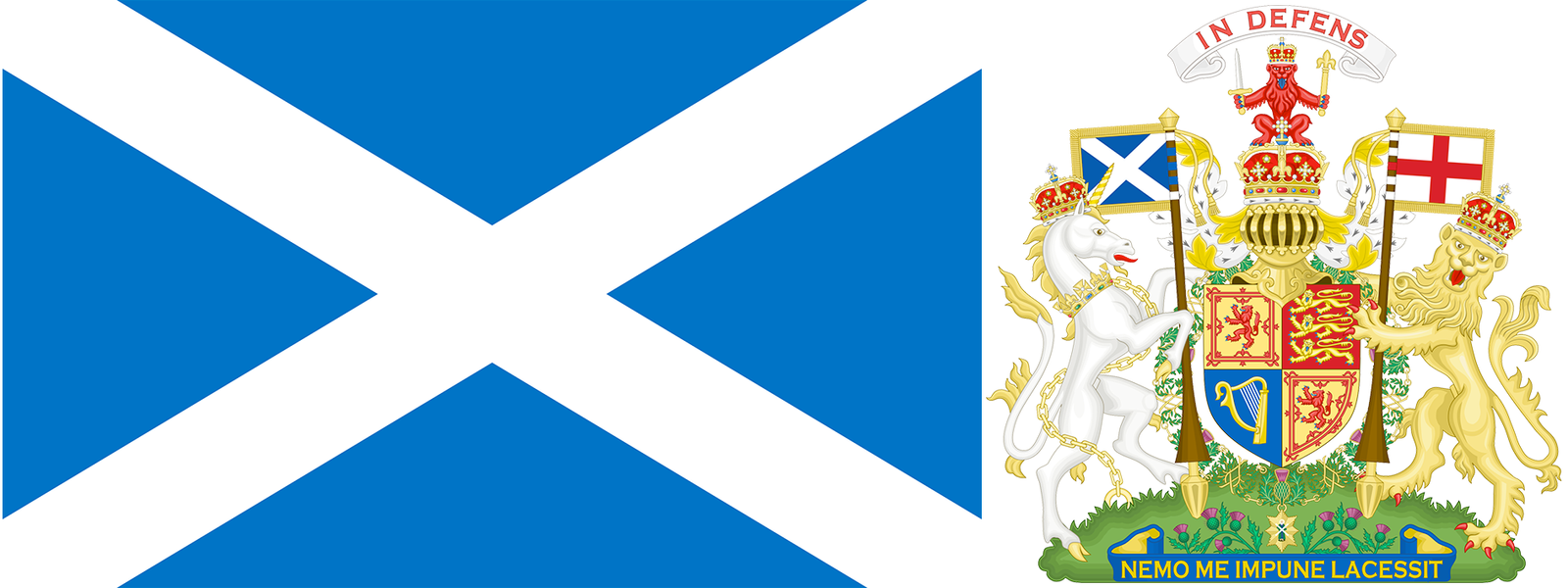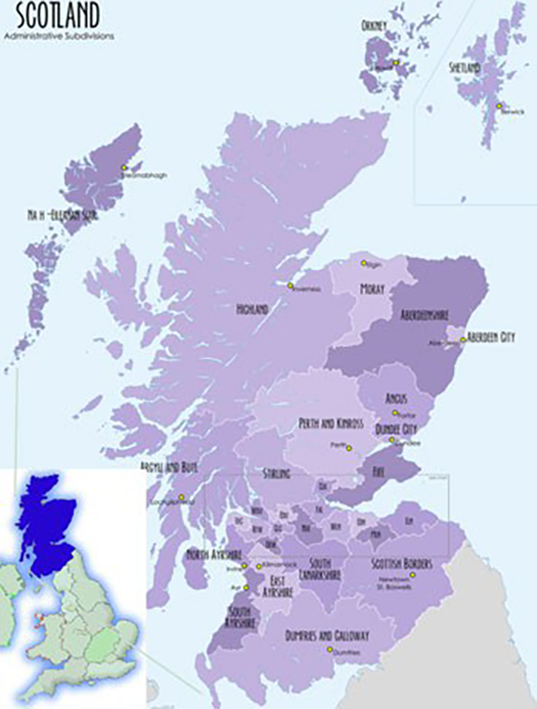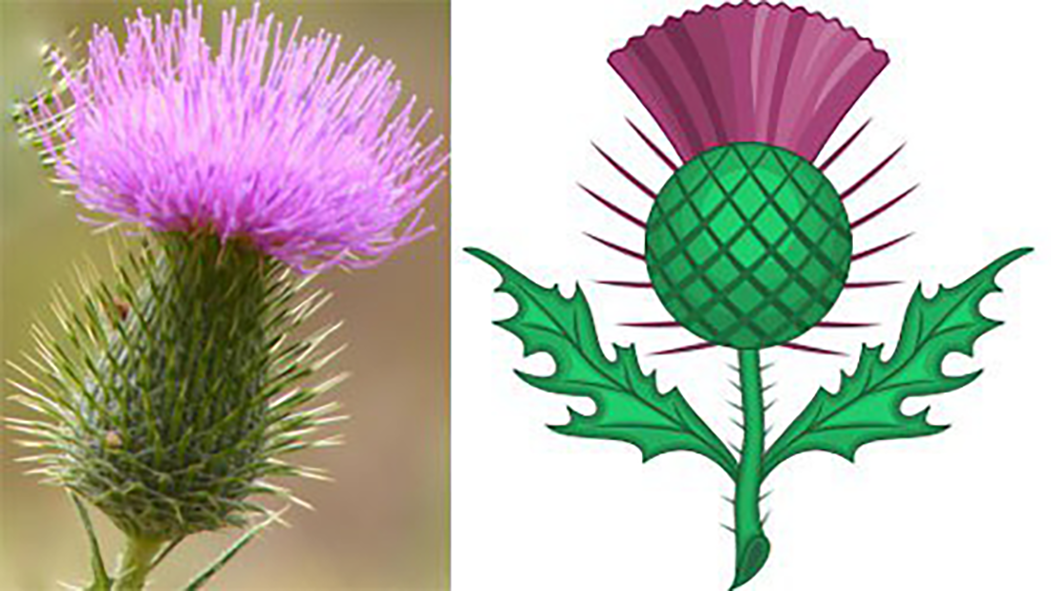FabulousFusionFood's Scottish Recipes (from Scotland) Home Page
 The flag of Scotland (left) and the coat of arms of Scotland (right).
The flag of Scotland (left) and the coat of arms of Scotland (right).
Welcome to the summary page for FabulousFusionFood's Scottish recipes for recipes from Scotland, part of the Celtic world. This page gives a listing of all the Scottish recipes added to this site. These recipes, for the most part, originate in Scotland. Otherwise they are modern recipes incorporating traditional Scottish ingredients, with 286 recipes in total.
Scotland is an old country, indeed it's flag, the saltire (white cross on a blue ground), depicting the cross of St Andrew is the most ancient national flag still used today. Foods have evolved from traditional Celtic one-pot stews through the stews, breads and vegetables of crofters and subsistence farmers through to the influences of large ports like Aberdeen, Dundee and Glasgow right up to date with the most modern of Scottish fusion and new wave cookery. All these types of Scottish recipes and dishes are presented here.
As a predominantly agrarian tenant economy much of the traditional cooking of Scotland reflects this heritage. Traditional food tends to be simple, utilising readily-available ingredients and those cuts of meat that were not readily saleable. Of late, however, many chefs have begun re-examining and re-interpreting these dishes. Novel dishes, incorporating local ingredients but using international techniques have also begun to appear on the culinary scene and though the overall list of dishes is biased towards the traditional some of these later dishes are also presented here. Enjoy...
The name 'Scotland' is derived from the Latin term 'Soti', a word originally applied to the Gaels of Hibernia (Ireland). Accordingly, the Late Latin word Scotia ('land of the Gaels') was initially used to refer to Ireland. However, by the 11th century the term Scotia was being used to refer to (Gaelic-speaking) Scotland north of the river Forth, alongside Albania or Albany, both derived from the Gaelic Alba (the modern Welsh for Scotland is still Alban [land of Alba]).
With the departure of the Romans from Britain in the fourth century, Irish Gaels invaded Pictland to form the Gaelic speaking Dál Riata whilst Anglo-Saxon invaders pressured the Brython from the South. By the eighth century Scotland was divided between Gaelic speakers and Germanic tribes who spoke a form of Anglo-Saxon that evolved into Lowland Scots dialect. Indeed, Anglo-Saxon English first evolved in lowland Scotland and not in England!
 Location of Scotland in Great Britain and a map of Scotland.The Kingdom of Scotland emerged as an independent sovereign state in the Early Middle Ages and continued to exist until 1707, although it had been in a personal union with the kingdoms of England and Ireland since James VI of Scotland succeeded to the English and Irish thrones in 1603.
Location of Scotland in Great Britain and a map of Scotland.The Kingdom of Scotland emerged as an independent sovereign state in the Early Middle Ages and continued to exist until 1707, although it had been in a personal union with the kingdoms of England and Ireland since James VI of Scotland succeeded to the English and Irish thrones in 1603.
It was during the time when Scotland was adopting a distinct political identity (the 10th century) that St Andrew was adopted as the patron saint of Scotland. According to legend, in 832 AD, Óengus II (the first recognized king of Sotlant) led an army of Picts and Scots into battle against the Angles, led by Æthelstan, near modern-day Athelstaneford, East Lothian.
The legend states that he was heavily outnumbered and hence whilst engaged in prayer on the eve of battle, Óengus vowed that if granted victory he would appoint Saint Andrew as the Patron Saint of Scotland. On the morning of battle white clouds forming an X shape in the sky were said to have appeared. Óengus and his combined force, emboldened by this apparent divine intervention, took to the field and despite being inferior in terms of numbers were victorious. Having interpreted the cloud phenomenon as representing the crux decussata upon which Saint Andrew was crucified, Óengus honoured his pre-battle pledge and duly appointed Saint Andrew as the Patron Saint of Scotland. The white saltire set against a celestial blue background is said to have been adopted as the design of the flag of Scotland on the basis of this legend.
Historically, however, it's known that St Andrew had been venerated in Scotland Before this. The Sottish saltire is the oldest national flag still in use. St Andrew's day, 30th November is still celebrated in Scotland and is now a national holiday.
In the main, the early Scottish state was essentially stable and peaceful, apart from a period in the late 13th and early 14th centuries where a succession dispute allowed the English to make a grab for the Scottish throne. This was only sorted when Robert the Bruce, Earl of Carrick made a claim for the Scottish throne and battled for 20 years to win Scotland back from the Norman English invaders piece by piece. Victory at the Battle of Bannockburn in 1314 proved that the Scots had regained control of their kingdom.
Though there was continued war with England through to the 15th century, the Scottish state was not threatened again. It was in 1502 that James IV of Scotland signed the Treaty of Perpetual Peace with Henry VII of England. He also married Henry's daughter, Margaret Tudor, setting the stage for the Union of the Crowns. For Henry, the marriage into one of Europe's most established monarchies gave legitimacy to the new Tudor royal line. It was this marriage that made James IV of Scotland the heir apparent to the English throne upon the death of Elizabeth I.
However, it was not until the 1st May 1707 that Scotland entered into an incorporating political union with England to create the united Kingdom of Great Britain. Even today, Scotland's legal system continues to be separate from those of England and Wales and Northern Ireland, and Scotland constitutes a distinct jurisdiction in public and private law.
In 1999, a devolved legislature, the Scottish Parliament, was reconvened with authority over many areas of home affairs following a successful referendum in 1997. Scotland's capital is the city of Edinburgh and the largest city is Glasgow and the industrial corridor lies on a line joining these two cities.
 The wild thistle (left) and the stylized Scottish thistle (right).Throughout this page you will see the traditional national symbols of Scotland, these are the red lion rampant (on the Royal emblem), the saltire (St Andrew's cross) and the thistle. St Andrew's Day, 30 November, is the national day, although Burns' Night tends to be more widely observed, particularly outside Scotland.
The wild thistle (left) and the stylized Scottish thistle (right).Throughout this page you will see the traditional national symbols of Scotland, these are the red lion rampant (on the Royal emblem), the saltire (St Andrew's cross) and the thistle. St Andrew's Day, 30 November, is the national day, although Burns' Night tends to be more widely observed, particularly outside Scotland.
There are also sea fish from the ocean and sea lochs and salmon and trout from the rivers and freshwater lochs. The national holidays have also meant that traditional foods like haggis, mashed potatoes, oatcakes, porridge and neeps (swedes) remain popular even today.
The 18th and 19th centuries brought more baking, particularly in the big cities and that tradition is still evident. Though foraging for mushrooms and wild vegetable and seaweed had almost died out by the 1980s modern chefs are bringing these dishes back to the tables of Edinburgh and Glasgow and there is a resurgence of new cookery in this old nation.
Scottish cuisine has distinctive attributes and recipes of its own but shares much with wider British and European cuisine as a result of local and foreign influences, both ancient and modern. Traditional Scottish dishes exist alongside international foodstuffs brought about by migration. Scotland's natural larder of game, dairy products, fish, fruit, and vegetables is the chief factor in traditional Scots cooking, with a high reliance on simplicity and a lack of spices from abroad, as these were historically rare and expensive.
Irn-Bru is the most common Scottish carbonated soft drink, often described as 'Scotland's other national drink' (after whisky). During the Late Middle Ages and early modern era, French cuisine played a role in Scottish cookery due to cultural exchanges brought about by the 'Auld Alliance', especially during the reign of Mary, Queen of Scots. Mary, on her return to Scotland, brought an entourage of French staff who are considered responsible for revolutionising Scots cooking and for some of Scotland's unique food terminology.
Scotland is an old country, indeed it's flag, the saltire (white cross on a blue ground), depicting the cross of St Andrew is the most ancient national flag still used today. Foods have evolved from traditional Celtic one-pot stews through the stews, breads and vegetables of crofters and subsistence farmers through to the influences of large ports like Aberdeen, Dundee and Glasgow right up to date with the most modern of Scottish fusion and new wave cookery. All these types of Scottish recipes and dishes are presented here.
As a predominantly agrarian tenant economy much of the traditional cooking of Scotland reflects this heritage. Traditional food tends to be simple, utilising readily-available ingredients and those cuts of meat that were not readily saleable. Of late, however, many chefs have begun re-examining and re-interpreting these dishes. Novel dishes, incorporating local ingredients but using international techniques have also begun to appear on the culinary scene and though the overall list of dishes is biased towards the traditional some of these later dishes are also presented here. Enjoy...
Scotland and its Cuisine
Scotland (Scottish Gaelic: Alba; Welsh Yr Alban) is a country that is part of the United Kingdom. Occupying the northern third of the island of Great Britain, it shares a border with England to the south and is bounded by the North Sea to the east, the Atlantic Ocean to the north and west, and the North Channel and Irish Sea to the southwest. In addition to the mainland, Scotland is made up of more than 790 islands including the Northern Isles and the Hebrides. The border with England runs between the basin of the River Tweed on the east coast and the Solway Firth in the west. This makes Scotland's total area 78,772 km2 (30,414 sq mi).The name 'Scotland' is derived from the Latin term 'Soti', a word originally applied to the Gaels of Hibernia (Ireland). Accordingly, the Late Latin word Scotia ('land of the Gaels') was initially used to refer to Ireland. However, by the 11th century the term Scotia was being used to refer to (Gaelic-speaking) Scotland north of the river Forth, alongside Albania or Albany, both derived from the Gaelic Alba (the modern Welsh for Scotland is still Alban [land of Alba]).
A Brief History of Scotland
When Scotland first emerges into recorded history (during Roman times) it was essentially divided between Pictland in the North and the Brythonic (ancestor tongue to Welsh) in the regions of Celyddon (Caledonia), Ystratclud (Strathclyde) and Eiddin (Edinburgh) to the south.With the departure of the Romans from Britain in the fourth century, Irish Gaels invaded Pictland to form the Gaelic speaking Dál Riata whilst Anglo-Saxon invaders pressured the Brython from the South. By the eighth century Scotland was divided between Gaelic speakers and Germanic tribes who spoke a form of Anglo-Saxon that evolved into Lowland Scots dialect. Indeed, Anglo-Saxon English first evolved in lowland Scotland and not in England!
 Location of Scotland in Great Britain and a map of Scotland.
Location of Scotland in Great Britain and a map of Scotland.It was during the time when Scotland was adopting a distinct political identity (the 10th century) that St Andrew was adopted as the patron saint of Scotland. According to legend, in 832 AD, Óengus II (the first recognized king of Sotlant) led an army of Picts and Scots into battle against the Angles, led by Æthelstan, near modern-day Athelstaneford, East Lothian.
The legend states that he was heavily outnumbered and hence whilst engaged in prayer on the eve of battle, Óengus vowed that if granted victory he would appoint Saint Andrew as the Patron Saint of Scotland. On the morning of battle white clouds forming an X shape in the sky were said to have appeared. Óengus and his combined force, emboldened by this apparent divine intervention, took to the field and despite being inferior in terms of numbers were victorious. Having interpreted the cloud phenomenon as representing the crux decussata upon which Saint Andrew was crucified, Óengus honoured his pre-battle pledge and duly appointed Saint Andrew as the Patron Saint of Scotland. The white saltire set against a celestial blue background is said to have been adopted as the design of the flag of Scotland on the basis of this legend.
Historically, however, it's known that St Andrew had been venerated in Scotland Before this. The Sottish saltire is the oldest national flag still in use. St Andrew's day, 30th November is still celebrated in Scotland and is now a national holiday.
In the main, the early Scottish state was essentially stable and peaceful, apart from a period in the late 13th and early 14th centuries where a succession dispute allowed the English to make a grab for the Scottish throne. This was only sorted when Robert the Bruce, Earl of Carrick made a claim for the Scottish throne and battled for 20 years to win Scotland back from the Norman English invaders piece by piece. Victory at the Battle of Bannockburn in 1314 proved that the Scots had regained control of their kingdom.
Though there was continued war with England through to the 15th century, the Scottish state was not threatened again. It was in 1502 that James IV of Scotland signed the Treaty of Perpetual Peace with Henry VII of England. He also married Henry's daughter, Margaret Tudor, setting the stage for the Union of the Crowns. For Henry, the marriage into one of Europe's most established monarchies gave legitimacy to the new Tudor royal line. It was this marriage that made James IV of Scotland the heir apparent to the English throne upon the death of Elizabeth I.
However, it was not until the 1st May 1707 that Scotland entered into an incorporating political union with England to create the united Kingdom of Great Britain. Even today, Scotland's legal system continues to be separate from those of England and Wales and Northern Ireland, and Scotland constitutes a distinct jurisdiction in public and private law.
In 1999, a devolved legislature, the Scottish Parliament, was reconvened with authority over many areas of home affairs following a successful referendum in 1997. Scotland's capital is the city of Edinburgh and the largest city is Glasgow and the industrial corridor lies on a line joining these two cities.
The Symbols of Scotland
 The wild thistle (left) and the stylized Scottish thistle (right).
The wild thistle (left) and the stylized Scottish thistle (right).Food and Cuisine:
Scottish cuisine, like most British cuisine has evolved from peasant cookery and is based heavily on the one grain, oats, that is guaranteed to grow in the damp and cold climate. As much of the agriculture, historically has been based on crofter-style smallholdings, there are many stews based on what a small farmstead could grow (vegetables, greens and chicken pork or mutton in the main).There are also sea fish from the ocean and sea lochs and salmon and trout from the rivers and freshwater lochs. The national holidays have also meant that traditional foods like haggis, mashed potatoes, oatcakes, porridge and neeps (swedes) remain popular even today.
The 18th and 19th centuries brought more baking, particularly in the big cities and that tradition is still evident. Though foraging for mushrooms and wild vegetable and seaweed had almost died out by the 1980s modern chefs are bringing these dishes back to the tables of Edinburgh and Glasgow and there is a resurgence of new cookery in this old nation.
Scottish cuisine has distinctive attributes and recipes of its own but shares much with wider British and European cuisine as a result of local and foreign influences, both ancient and modern. Traditional Scottish dishes exist alongside international foodstuffs brought about by migration. Scotland's natural larder of game, dairy products, fish, fruit, and vegetables is the chief factor in traditional Scots cooking, with a high reliance on simplicity and a lack of spices from abroad, as these were historically rare and expensive.
Irn-Bru is the most common Scottish carbonated soft drink, often described as 'Scotland's other national drink' (after whisky). During the Late Middle Ages and early modern era, French cuisine played a role in Scottish cookery due to cultural exchanges brought about by the 'Auld Alliance', especially during the reign of Mary, Queen of Scots. Mary, on her return to Scotland, brought an entourage of French staff who are considered responsible for revolutionising Scots cooking and for some of Scotland's unique food terminology.
The alphabetical list of all Scottish recipes on this site follows, (limited to 100 recipes per page). There are 286 recipes in total:
Page 1 of 3
Page 1 of 3